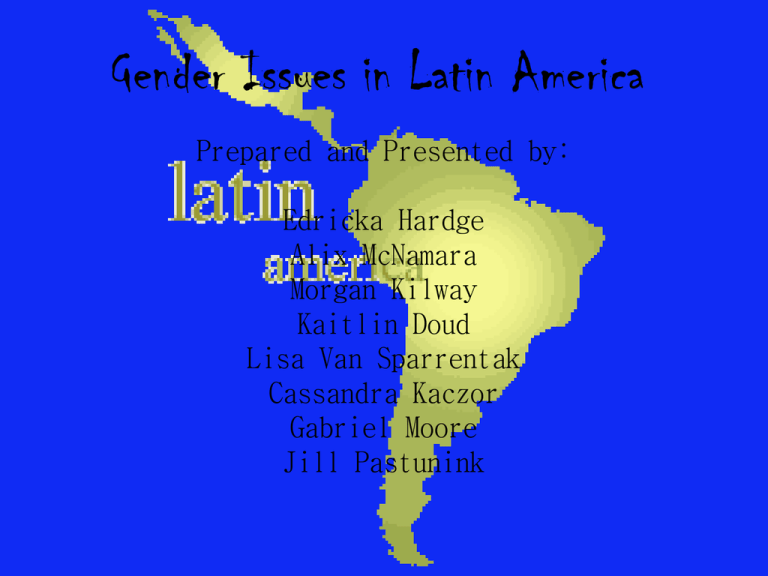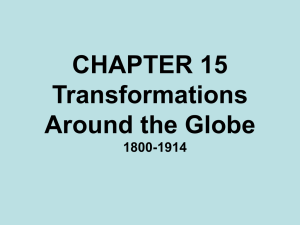
Gender Issues in Latin America
Prepared and Presented by:
Edricka Hardge
Alix McNamara
Morgan Kilway
Kaitlin Doud
Lisa Van Sparrentak
Cassandra Kaczor
Gabriel Moore
Jill Pastunink
The Role of Women in Latin
America
Morgan Kilway
The Family
• Patriarchal Society- male centered in family
life as well as in government.
• Women traditionally thought of as caregivers,
the men, in theory, “bring home the bacon”
• Although families tend to be patriarchal in
Latin America, female headed households are
on the rise.
The Family Continued
• More education opportunities available to
women, less sex-specialized skills needed, for
example; women need men to do market
work, therefore they do the house work. This
makes women more independent.
Poverty
• In Costa Rica, poverty is “feminizing”- a
significant rise in poverty of female lead
households.
• Women represent a disproportionate amount
of Latin America’s poor.
• However, some firms prefer to hire women
such as Maquiladoras along the U.S. Mexico
border.
Politics
• Women are becoming more involved in politics
• Law passed in 2003 in Mexico banning
discriminations in the workplace and protect
reproductive rights
• Between ‘96 and ‘06 laws were passed dealing
with family violence intended to protect the
family from the family, an attempt to thwart
patriarchy.
• Women are becoming more aggressive in politics,
fighting for institutionalized equality and
demanding more power.
In Conclusion…
• The roles of women in Latin America are
changing, in some ways following the pattern
set in the U.S.
• Although women are gaining more political
power, they are still disproportionately
disadvantaged compared to men, policy
changes should attempt to correct this
disparity.
Women’s Self-Perception in Latin
America
Effects of Gender Expectations, the Media and
Reggaeton Culture, Eating-Disordered Influence
and Prevailing Stereotypes
Cassandra Kaczor
Gender Expectations
• Predominantly Catholic, it is suggested to women to be
chaste and modest
• “Young women were encouraged to be chaste and modest...to go to church and
behave. In many families, dating was prohibited and sex education was not
administered...”-Rosie Molinary
• “Be a good girl in life, and a bad girl in bed...” -Molinary
• Equal pressure to start a family: due to Machismo culture,
women feel pressure to dress more seductively, as this is
“the look” that “gets the guy”
• “There was pressure to be feminine...several women wrote that they were expected
to wear makeup every day.” -Molinary
• Must be obedient to males, or simply put up with advances
to get work
• “I recall hearing about the harassment that Puerto Rican women endured in factories
where the "boss men" talked to them as if sexual innuendo was all they understood
and, worse, often gave them the choice of submitting to advances or being fired.” Judith Ortiz Cofer
• Job discrimination based on how attractive you are is very common. (Casanova 289)
The Media and Reggaeton Culture
• Definition of reggaeton, according to hiphoprepublican.com
– “Reggaeton has empowered the Hispanic Caribbean youth, specifically
those of Puerto Rico, Panama, Dominican Republic, Venezuela, and
Mexico as well as the Latin American audience and the Latino
communities in the United States, with a musical genre as a voice. Like
hip hop, reggaeton has caused controversy due to its often explicit lyrics
and alleged exploitation of women .”
• Seeing women as sex objects, hood ornaments for cars.
Obscene lyrics.
• Women frequently feel the need to conform, to attract a mate,
and to blend in with the popular culture.
– [Reggaeton’s Lyrics are] "not just explicit, but violently explicit" and
"extremely misogynistic." -Raquel Z. Rivera, a sociologist specializing in
reggaeton
– “Although individual rappers are typically wealthy from their music
careers, they maintain a “ghetto aesthetic” that connects their style and
consumption patterns to the black and Latino poor.” -Margaret Hunter
Eating-Disordered Behavior in Latinas
• Acculturation after the introduction of American
media has a huge effect
• Overall thinness is not as important as in the U.S.;
there is an emphasis on “curves,” however, this
emphasis includes “a thin waist.” [Casanova]
• Desire to look Caucasian and White [Casanova]
• The National Eating Disorder Association found that:
• “among the leanest 25% of sixth- and seventh- grade girls, Asians and
Latinas reported significantly more body dissatisfaction than did white
girls...Latinas were the second highest group trying to lose weight--at
36.1%...”
• And: “In the...survey, 50.8% of [Latina] women said that they were
unsatisfied to very unsatisfied with their weight; 74.2% of them had
dieted at some point in their lives.” [Molinary]
Prevailing Stereotypes
• After searching through many blog postings and
internet forums, I was disgusted to see how
Latina women were discussed by both Caucasian
and Latin American men.
– Discussions ranged from sexist comments to
sexual expectations to stereotypes, many of
which are listed by Latina women themselves
on the following slide
•
“When a Puerto Rican girl dressed in her idea of what is attractive
meets a man from the mainstream culture who has been trained to
react to certain types of clothing as a sexual signal, a clash is likely to
take place.” -From Myth of a Latina Woman
Prevailing Stereotypes
[continued]
• “When asked to list any stereotypes, [Latina women] feel exist about
Latinas, the ten most common sex- and gender- related answers
were the following:
1. we’re promiscuous
2. we get pregnant all the time
3. we’re oversexualized
4. we’re teenage moms
5. we are uneducated and let our men beat us
6. we have no aspirations outside of getting married and having kids
7. we are freaky in bed
8. we all have big breasts and butts
9. we wear too much makeup, our clothes are too tight, and our hair is
too big
10. we all have many children and are on welfare, trying to cheat the
system”
[Molinary]
Sources
•
•
•
•
•
•
•
Molinary, Rosie, Hijas Americanas: Beauty, body image, and growing up Latina.
(California: Seal Press, 2007)
Smith, Christopher Holmes. 2003. “‘I Don’t Like to Dream About Getting Paid’:
Repre-sentations of Social Mobility and the Emergence of the Hip-Hop Mogul.”
Social Text21(4):69–97.
Casanovia, Erynn Masi de. ““No Ugly Women”: Concepts of Race and Beauty among
Adolescent Women in Ecuador,” Gender and Society, Vol. 18, No. 3 (2004): 287308, accessed 18 June 2011. http://www.jstor.org.libproxy.library.wmich.edu/stable/4149403
Ceulemans, Meike and Fauconnier, Guido. (1979). “Mass Media: The Image, Role,
and Social Conditions of Women.” (diss. Department of Communication Science,
Catholic University of Leuven)
Ortiz Cofer, Judith. (1993). “The Myth of the Latin Woman: I Just Met a Girl Named
Maria” (From “The Latin Deli: Prose & Poetry”), University of Georgia Press
“Eating Disorders in Women of Color: Explanations and Implications,” National
Eating Disorders Association (2005), accessed 11 June 2011,
http://www.nationaleatingdisorders.org/nedaDir/files/documents/handouts/Wome
nCol.pdf
Yahoo and Google blogs, accessed May 2011
Employment Gender Inequality
in Mexico
Alix McNamara
Statistics
• Population: 113,724,226
– Males : 55,586,964 (49%)
– Females: 58,137,262
(51%)
This map shows the
gender disparity throughout
the country and which areas
where the disparity is
the greatest
Employment
• Overall throughout the country jobs available to
men outweigh the jobs that are available to
women, despite the fact that there are more
women in the country then men
•Women in the workforce
• Maquiladoras a source for employment
opportunities
•Paid less then a man
•They are better at handling the tedious factory work
•Informal Sector
•Many women turn to the informal sector for work,
as do the men, in the hopes of finding a job that
pays higher then minimum wage
•Wage disparities
•Many men are paid higher then women for the same
job
Education
• Getting an education is more difficult for many women
– Traditional roles of women as the caretaker of the family
• Literacy rates are much higher for men then for women
• Discrimination in acceptance to higher education
(colleges/universities)
Politics
• Women in a place of authority
– Hard for some women to gain as much respect as men and to be taken
seriously
– Often times thought of as not strong enough
• Education a factor
– Having a good education is a big deal when you are thinking about
entering into politics which can be harder for a woman then a man
Religion/ Traditional and Cultural
Values
• Mexicans, as opposed to other cultures are less supportive of
non-traditional values
• Traditionally women are the caretakers of the family and stay at
home the majority of the time
– Women’s work at home can sometimes be more socially vital then
a man’s work outside of the home
– Women, in Mexican culture, are generally thought of as the head of
the family
• Traditionally their job was to take care of everyone and to take car of
the home
Sources
"Females, Males and Gender Inequality in Mexico." Geo-Mexico, the Geography of
Mexico. Web. June 2011. <http://geo-mexico.com/?p=140>.
"Gender Equality in Mexico - Wikigender.org." New Home - Wikigender.org. Web.
June 2011. <http://www.wikigender.org/index.php/Gender_Equality_in_Mexico>.
Marquez, Celina M. "An Introduction to MEXICO & the Role of Women." West
Virginia University. Web. June 2011.
<http://www.wvu.edu/~exten/infores/pubs/fypubs/mexico.pdf>.
"Mexico." CIA - The World Factbook. Central Intelligence Agency, 17 May 2011. Web.
June 2011. <https://www.cia.gov/library/publications/the-worldfactbook/geos/mx.html>.
Schmitz, Kim, and Sarah Diefenthaler. "An Examination of Traditional
Gender Roles
Among Men and Women in Mexico and the United States." 1998.
Web. June 2011.
<http://murphylibrary.uwlax.edu/digital/jur/1998/schmitz.pdf>.
Winn, Peter. Americas: the Changing Face of Latin America and the
Caribbean.
Berkeley, CA: University of California, 2006. Print.
Religion and Gender Roles in Latin
America
Jill Pastunink
• Traditional Catholicism reinforces women’s
subornation particularly in their exclusion from
public life.
• Over the last few decades new religious trends
have emerged challenging traditional Catholic
Culture including:
– Comunidades eclesiales de base (base communities
or CEB’s)
– Growth of Protestant Pentecostal religious groups
• Religious groups are offering new organizations
or participatory structures drawing people into
new roles because of Pentecostalism and CEBs
Symbolic Opportunities CEBs and
Pentecostal Groups Offer Women
Traditional Catholicism
• Men are the nominal heads of
the households
• Women must fulfill their
God-given feminine
destines.
• Women cannot be priests.
• Ignored sexism as a
source of oppression.
Influence of CEBs and
Pentecostal Groups
•Both men and women must submit to the will of God
–Pentecostalism scripture states equality
before Christ more directly contradicts female
subornation.
•CEB does not speak of this, rather that
women have special roles and talents that
spring from their biological roles as
mothers.
•In Pentecostal women have a commitment to preach
•Unfortunately in the 1983 pastoral
campaign sexual violence by women was
never addressed. Material presented
women as suppressed only in the sense
the society denied them the resources to
meet their families needs.
• The Pentecostalism and the Liberationist
church provide some ideas that could change
women’s gender roles
• However these are based on embedded
beliefs that can reinforce traditional roles
• Still, these groups offer them opportunity for
leadership and empowerment.
Participatory Opportunities CEBs and
Pentecostal groups offer women
•
Both groups opens opportunities for women to lead other women
– Both Brazilian CEBs and Colombian Pentecostal churches encourage the formation of mothers’
or women’s clubs.
•
•
Also provide neighborhood prayer groups held at home by women.
Women can also lead religious services in discussion groups
– Though these activities they may learn useful skills like public speaking, than may also gain an
important measure of confidence.
•
Opportunities available in the church
– Catholicism offered few leadership opportunities for women inside the church.
– Pentecostal women can attain leadership and status by becoming faith healers
– Opportunities in nontraditional preaching roles
•
Aimee Semple McPherson founded the Foursquare Gospel, a major Pentecostal church
– In CEBs both women and men can organize and lead the official Sunday celebrations when in
absence of a priest
•
Remaining Restrictions
– The Catholic Church continues to ban female ordination
•
Therefore will never reach top roles
– Some Protestant churches have no formal ban or ordination but seems to informally deny
women’s leadership last a certain level.
– Religion does not open new career or income opportunities for women
What Extent do Pentecostal Women
Take Advantage ?
•
•
In Quetzaltenango, Guatemala a 2,000 member church originated in a Presbyterian women’s prayer
circle. This examples shows the potential for women leaders is significant, but women do not
respond to the opportunities in great numbers
In general, Pentecostal women are not active as preachers on leaders outside of sex-segregated
prayer groups
–
Most Pentecostals are poor, more so than CEBs members.
•
•
–
•
Therefore many member are employed outside the home
This may lead them to see this not as a desirable expansion of their roles or a key to independence but as a burden to
their home.
It is difficult to see if their new religious roles carry over to politics because Pentecostals generally appear
mistrustful of politics in general.
Women have made gains in the authority in the home
–
Pentecostal women are able to capture a larger share of male income for the family
•
–
Regaining control of income spent on alcohol and extramarital affairs.
All poor women want to gain greater control over husbands income but Pentecostal women have an
advantage of doing so.
•
•
•
•
Male converts are essentially called upon to adopt female moral norms
Renounces spending on drinking and women
They must bring their spending in line with female preferences for spending on family consumption.
Only 7% of Presbyterian and Foursquare women said women should be obedient to their husbands, in contrast to 36
percent of women from other denominations.
What Extend do CEB Take Advantage
• CEB women appear more likely to expand their new roles
to public spheres than Pentecostals.
– More involved in religious actives in sex-integrated groups, more
predominate in community councils, liturgy committees, and
important public ministries like baptism, leading Sunday worship
services, and many serve as community representatives
• Appear to facilitate women’s expansion of nonreligious public roles
• Differ a little from Pentecostals in terms of domestic gender
roles
– Their roles produce more domestic problem, usually from
husbands
– More likely to identify with traditional domestic roles.
Sources
Alvarez, Sonia. 1990. “Women’s Participation in the Brazilian ‘People’s
Church’: A Critical Appraisal,” Feminist Studies 16: 2.
Briggs, Sheila. 1987. “Women and Religion” in Beth B. Hess and Myra Marx
Ferree, eds., Analyzing Gender: A Handbook of Social Science
Research (Beverly Hills: Sage).
Brusco, Elizabeth. 1986. “The Household Basis of Evangelical Religion and
the Reformation of Machismo in Colombia.” PhD Dissertation, City
University of New York.
Burdick, John. 1990. “Gossip and Secrecy: Women’s Articulation of
Domestic Conflict in Three
Drogus, Carol. 1994 "Religious Change and Women's Status in Latin
America.
Gender Wages In Brazil
Gabriel Moore
Brazilian Census Form 60’s to 2000
• Gender wages on the Brazilian census shows,
from 1960-2000 that long term trends in racial
and gender wages disparities in the urban market
of Sa Paulo, that Afro- Brazilians and women have
made remarkable progress over the past four
decades in securing rights and gaining access to
the highest levels of schooling, entrance into
higher paying occupations, and narrowing the
gender wage gap. Despite the progress AfroBrazilians and women are paid less than qualified
whites, and wage discrimination is increasing (
Peggy A lovell.1).
Men Vs Women and the disparities of
school and occupations
•
•
•
•
•
Men
Afro- Brazilian men percent of
schooling during the 1960 was 1
percent and went up to 29 percents
in the 2000.
Afro- Brazilian exclusively employed
94.2 percent of the blue collar jobs
like manufacturing, service, and
domestic work .
white men percent of schooling was
ranging from 1960 1 percent and
went up to 50 percent in the 2000 .
White men often get the higher
paying jobs occupational jobs . Even
if the their educational levels does
not meet the qualifications.
Women
the percent of afro- Brazilian women
completed nine or more years of school
was 2 percent in 1960 and rose 37 percent
in the 2000 that is a 35 percent difference
over the past 40 years.
Despite the consistent overall educational
advantages, and racial inequalities only 6
percent of Afro-Brazilian women are
employed after completing 12 or more
years of schooling compared to 23 percent
of white women respectively is employed
white women who had completed nine or
more years of schooling increased from 18
to 61 percent over the four decades
23 percent of white women respectively is
employed .
Afro- Brazilian vs White women's
occupations
•
•
•
•
66 percent of Afro-American women work as domestic servants compared to 24 percent of
white women.
white women make up 37 percent of the higher paying administrative, professional, and
clerical occupations.
Over the next two to three decades, in Sao Paulo developed a highly diversified industrial
economy, more Afro- Brazilian women began to make significant progress inserting
themselves into the more "pink" and white-collar occupations for instance (
clerical,professional,and administrative jobs) increased by 28 percent between 1960 and
1991 (Peggy A Lovell5).White women experienced a similar 27 percent gain in proportion
employed in the higher-status occupations (Peggy A Lovell5). The racial index of dissimilarity
among women declined from 35 percent in 1980 to 30 percent in 1991 indicating an overall
narrow racial gap among women in occupational distribution (Peggy A Lovell5).
Despite these gains of afro-Brazilian women being employed as domestic servants remained
about 38 percent in both the 80's and 90's. In 2000, both racial groups exit out of the "pink"
and white- collar occupations and entered into lower-paying service jobs (Peggy A Lovell5).
Afro- Brazilian women that were in the "pink" and white-collar occupations jobs declined 12
to 8 percent respectively from the 90's to 2000 (Peggy A Lovell5). During this decade, white
women employed grew from 7 percent to 22 percent T (Peggy A Lovell5).The Afro-Brazilian
women education decline.
Age Structure between Genders
Landowners strategy to reducing cost is to employ women that range
from the ages of 30s and 40s. But significantly hire women that are
in there 50s.
Landowners don’t hire women less than the age of 30 because they
are consider not disciplined and may not be use of the long hours.
According to landowners interviews over 70 percent of the women
between the ages 30 to 50s.
Landowners explained that women with more experience and who are
married and have responsibilities they tend to take work more
seriously . And the landowners preferred that because they are
perceived to be more passive and interested in getting involved in
political activities. And less likely to flirt with the male workers and
generally have more experience of working in the Grape branch.
Continued
• Land owners tend to hire young men in the
teens
• Land owners fill that young men can handle
the physical task and are more focus unlike
younger women.
• Landowners don’t like to hire men that are
approaching the age of retirement .
Gender Discrimination and Harsh
Working Conditions for Women:
Maquiladoras in Mexico
Lisa Van Sparrentak
Introduction to Maquiladoras
• When the United States and other more
industrialized countries began building
factories, or maquiladoras, just over the
U.S. Mexican border, workers migrated
from all over Mexico for the chance
make money.
• Harsh working conditions (long hours, no
breaks)
• Little sleep
• Extremely poor living conditions (no
running water or electricity)
• Pick food from garbage piles
• Cannot keep a family out of poverty even
with a job
Background
• Just over the U.S./Mexican border there are over 3,000
maquiladoras manufacturing and export assembly plants;
huge companies such as Sony, Ford, General Electric, and
Panasonic. The United States, Japan, and Europe are the
main owners of these harsh working environments
• Began in the 1960’s /NAFTA with U.S., Canada, and Mexico.
• The companies that have products made in these
maquiladoras only pay for the value added; the cost of the
labor.
• Pay $0.55 to $7 an hour, workers cannot even buy the
products they make, let alone support their families.
Discrimination Against Women
• About 2,000 more maquiladoras were built, employing
500,000 workers. These factories produce electronic
equipment, clothing, plastics, furniture, appliances, and
auto parts. Ciudad Juarez has the most maquiladoras of all
Mexican cities (308 plants).
• Women make up the majority of the workers in these
maquiladoras because they are believed to be the more
docile workforce, can be paid less than males, and are
believed to have better manual dexterity
• Women hired at extremely young age
• Before they are married and ready to start a family
• Maquiladoras enforce birth control to prevent this, or
workers are fired
Discrimination Cont’d.
• The cultural beliefs in Mexico almost allows
the factories to ignore when a woman is
beaten, raped, or assaulted at work. Because
of their beliefs that a woman’s place is in the
home, if she is beaten, raped, or assaulted it is
her fault; she was in a place that she shouldn’t
have been.
• In conclusion I feel that while the negative
impacts of maquiladoras far outweigh the
positive, they will not be leaving our society
any time soon. While workers are being
exploited and can barely afford food and
housing, they are still willing to work in
maquiladoras as they provide employment to
anyone looking for a job.
• Leaves the people of Latin America with a
terrible impression of the U.S.
Sources
•
Brown, Cynthia J, Wendy V. Cunningham. Gender in Mexico’s Maquiladora Industry. The University
of Texas-Pan American. 2002 <http://ea.panam.edu/cbest/pdf/s8.pdf >.
•
Catalist. Mexico Making Progress in Gender Equality. 9 March 2011.
<http://thecatalist.org/2011/03/mexico-making-progress-in-gender-equality/>.
•
Cravey, Altha J. Women and Work in Mexico’s Maquiladoras. United Kingdom: Rowman and
Littlefield, 1998.
<http://books.google.com/books?hl=en&lr=&id=rVpeJt_o93IC&oi=fnd&pg=PR9&dq=maquiladoras
+academic+articles&ots=9bQ3X1o731&sig=ul5Uu4pNIfdvFmAbuxXysG_j2qo#v=onepage&q&f=fals
e>.
•
Jorgensen, Sierra. Maquiladoras and the Exploitation of Women's Bodies. 2004
<http://serendip.brynmawr.edu/sci_cult/courses/knowbody/f04/web2/sjorgensen.html>.
•
Vargas, Lucinda. The Border Economy. Maquiladoras: Impact on Texas Border cities. Federal
Reserve Bank of Dallas. June 2001 <http://dallasfed.org/research/border/tbe_vargas.html>.
•
Winn, Peter. Americas. “The Changing Face of Latin America and the Caribbean.” Third Edition.
Los Angeles: University of California Press, 2006
•
World Bank. Poverty in Latin America and the Caribbean. “The Economics of Gender in Mexico:
Family, Work, State and Market.” 2011
<http://web.worldbank.org/WBSITE/EXTERNAL/COUNTRIES/LACEXT/EXTLACREGTOPPOVANA/0,,co
ntentMDK:20404060~pagePK:34004173~piPK:34003707~theSitePK:841175~isCURL:Y~isCURL:Y,00.
html>.
Women and Gender Issues
Women and Politics in Chile
By: Edricka Hardge
Women fighting for democracy
• In Chile, politics was an issue that only men
were supposed to deal with. Women were
expected to stay in the household and take
care of the family.
• Because of this, many feminist women started
to organize groups to fight for equality,
democracy, and peace in their country.
Political Movement Organizations
• One of the groups created during the 1930’s
were called MEMCH (the movement for the
emancipation of Women in Chile).
• This organization was formed to open the
door for social and political influence. They
demanded political rights for women, and also
to create more jobs.
• In 1949 women received the right to vote with
the help of MEMCH.
“Women for Life”
• During the 1980’s when General Augusto
Pinochet was still the dictator of Chile, a
group was formed to restore democracy and
to prevent people from voting for Pinochet in
the upcoming election.
• This organization was successful in convincing
people not to re-elect and for this reason the
economy turned around and more jobs
became available.
Michelle Bachelet 1st Female President
• Attended the University
of Chile and studied
medicine.
• In 2002 she was elected
head of the Defense
Ministry , being the first
woman in charge of the
administration.
• Served as president from
2006-2010, she fought
for women, education,
reduction of poverty.
Sources
www.britannica.com/EBchecked/topic/1009973/Michelle-Bachelet
countrystudies.us/chile/85.htm – goggle search “Chile democracy
history”
latinamericanhistory.about.com/pinochetbio.htm
www.memoriachilena.cl/temas/index.asp?id-ut=memch (1935-1953)
socialsciences.scielo.org/pdf/s-rh/vlnse/scs_a02.pdf
womenhistory.about.com/od/headofstate20012010/p/Bachelet_chile.htm
www.womensnews.org/story/domesticviolence
Winn, Peter – Americas “The Changing Face of Latin America and the
Caribbean” Third Edition: University of California Press © 2006
Sex trafficking/Human trafficking
Kaitlin Doud
What is human trafficking?
• “Human trafficking is a form of modern-day
slavery where people profit from the control
and exploitation of others.”
• Elements of force, fraud, or coercion are used
to control people. Then, that control is tied to
inducing someone into commercial sex acts,
or labor/services.
• Source: http://www.polarisproject.org/human-trafficking/overview
International trafficking
• “Human trafficking affects every country
around the world, regardless of socioeconomic status, history, or political
structure. Human traffickers have created an
international market for the trade in human
beings based on high profits and demand for
commercial sex and cheap labor”
• Source: http://www.catwinternational.org/about/index.php#harm
Statistics
• An estimated 27 million people are in modern-day
slavery across the world.
• 161 countries are reported to be affected by human
trafficking by being a source, transit, or destination
count.
• The majority of trafficking victims are between 18 and
24 years of age.
• 53% of victims are used for forced commercial sexual
exploitation, of whom 98 percent are women and girls.
• All statistics were found at:
– http://www.polarisproject.org/human-trafficking/international-trafficking
Where are victims trafficked
to and from?
Source: http://www.unasouthernny.org/ypic/index.php?option=com_content&view=article
Latino Residential Brothels and other
Related Trafficking Networks
• Residential brothels are typically informal, cash-based underground
businesses which operate in residential and non-commercial areas.
– Common venues include: homes, town homes, condos, apartments,
and trailers. Typically, residential brothels maintain a flexible and
mobile status. The majority of Latino residential brothels tend to be
“closed networks,” restricted for Latino men only.
• These brothel networks frequently do not advertise through formal
venues such as online or through paid advertising in newspapers,
magazines, or the Yellow Pages. Instead, they get the word out
through the low- cost printing and distribution of business cards
(a.k.a., “tarjetas”) and through word of mouth.
• Source: Latino Residential Brothels At-A-Glance, Polaris Project
– http://www.polarisproject.org/resources/resources-by-topic/sextrafficking
Latino Residential Brothels and other
Related Trafficking Networks cont.
• The victims present within these networks are almost always
women and children from Latin America and are recruited through
a variety of means.
• The individuals providing commercial sex within these brothel
networks are in a situation where they have commercial sex with
high volumes of men per day. With typical business hours often
spanning a 12 hour day, the women in these locations may have sex
with more than 20, 30, or even 40 men per day.
• Women typically live and sleep at the brothel location and often do
not leave the premises while located in a specific residence. Then,
the women are rotated to a new location every 1-2 weeks.
• Source: Latino Residential Brothels At-A-Glance, Polaris Project
– http://www.polarisproject.org/resources/resources-by-topic/sextrafficking
Take action!
• The Polaris Project:
– http://www.polarisproject.org/human-trafficking/internationaltrafficking
• United Nations Association:
– http://www.unasouthernny.org/ypic/index.php?option=com_content
&view=article&id=70:peht-the-numbers&catid=35:mobilize
• The Coalition Against Trafficking in Women:
– http://www.catwinternational.org/about/index.php











